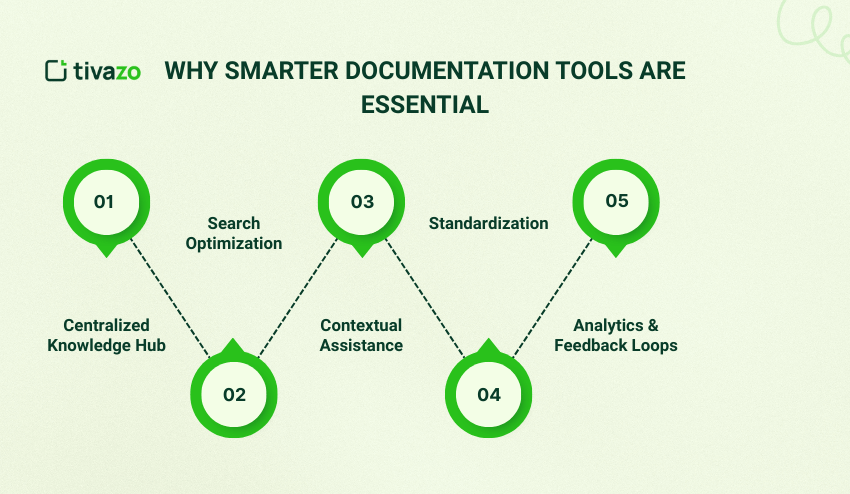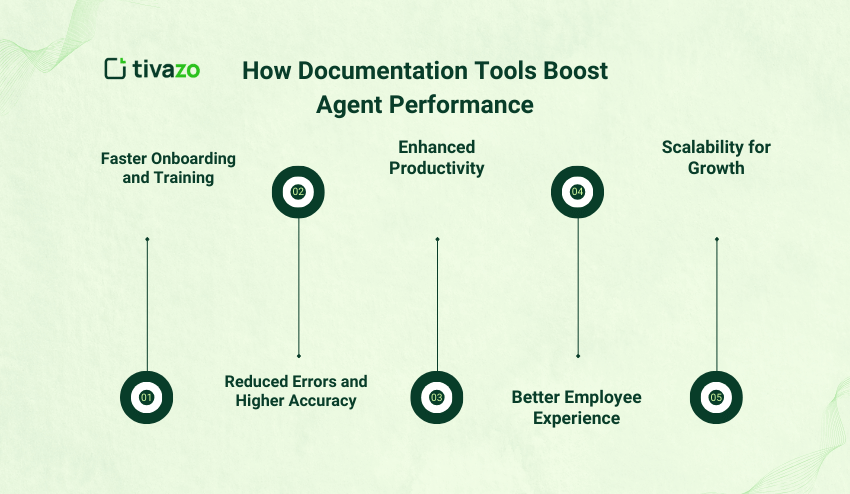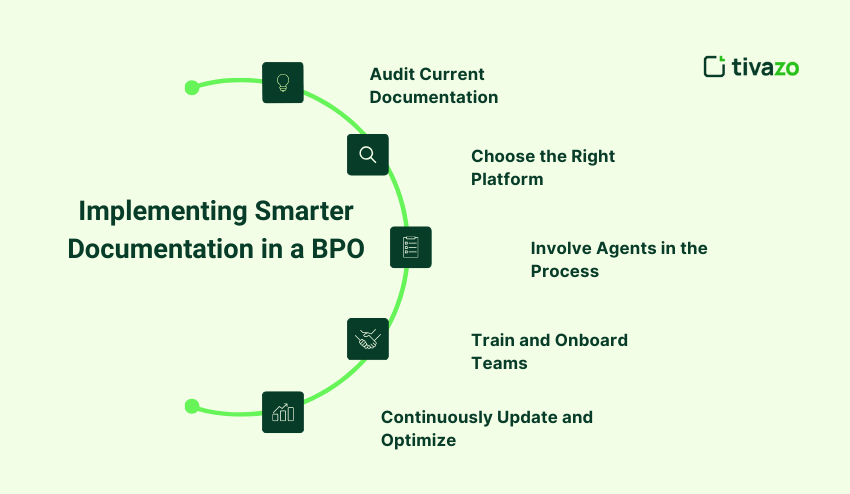Business process outsourcing (BPO) is a powerful technique. It allows companies to outsource specific portions of their business, such as customer support or payroll, to other more experienced companies. It allows them to focus on their product/service instead of spreading themselves thin by trying to do everything.
However, for BPO to succeed, there is a much-needed requirement: smart documentation. You see, BPO agents are expected to be quick on their feet and handle operations quickly and accurately. However, they can’t do that if they don’t have access to the right information.
Without a smart documentation solution, agents have to constantly waste time hunting down various information, code, or any necessary resources they require. This not only makes their work subpar but also inflates the costs.
In this article, we’ll explore how documentation challenges affect BPOs, the role of smarter documentation systems, and practical ways companies can leverage them to boost agent performance.
Key Highlights:
- Documentation Challenge in BPOs
- Why Smarter Documentation Tools Are Essential
- How Documentation Tools Boost Agent Performance
- Features to Look for in Smarter Documentation Tools
- Implementing Smarter Documentation in a BPO
The Documentation Challenge in BPOs
No matter what kind of process is being outsourced, BPO agents will require documentation for it. Now, the most commonly outsourced process is customer support.
That’s why BPO environments are inherently fast-paced. A single agent may handle dozens of customer interactions per day across different accounts, processes, and service levels. Now, imagine if the agent had to do all of that without proper documentation. You don’t have to; we have listed some of the most common problems that improper documentation can raise for BPO agents.
Without proper documentation support, they face hurdles such as:
- Information silos. Instead of one centralized knowledge base, critical data and details are scattered across emails, outdated spreadsheets, or even multiple knowledge bases. So, it becomes hard to track them, and in many situations, data may be lost or not retrieved in time.
- Slow onboarding. It slows down the training and onboarding of new hires. They may spend weeks learning complex processes. This time can be easily cut down with smart documentation, which new hires can access on their own.
- Inconsistent responses. Perhaps one of the greatest disadvantages of a lack of standardized documentation is that it leads to errors and miscommunication with clients or customers.
- High cognitive load. Without easily accessible and manageable documentation, agents have to juggle multiple tabs, systems, and guidelines mentally. This slows them down considerably and increases their stress. In severe situations, it can even lead to burnout.
- Time wasted searching. Studies show that employees spend up to 20–30% of their time searching for information instead of performing tasks. In BPO scenarios, that is a lot of wasted time and results in the loss of productivity.
For BPO companies, these inefficiencies don’t just hurt productivity; they are a big enough issue to get them fired/let go. That’s because these things affect service quality and client satisfaction, and that can lead to a bad reputation as well as loss of profits.
Why Smarter Documentation Tools Are Essential
So, we have established that traditional documentation methods, such as static manuals and scattered file storage, are not fit for modern BPO. We have learned that bad documentation can lead to terrible outcomes. So, how do we solve this conundrum?
Smarter documentation tools and knowledge bases are the solution here. Given below is a list of benefits afforded by modern documentation tools. Let’s check them out.

1. Centralized Knowledge Hub
Modern documentation tools provide a centralized knowledge hub. All process guides, policies, and client-specific instructions are stored in one place. Thus, ensuring agents don’t waste time looking through multiple systems and don’t accidentally overlook or ignore files.
2. Search Optimization
Modern knowledge bases and document management software provide advanced search capabilities that allow agents to find the relevant documents and answers in seconds. Naturally, this cuts down on response time during live interactions and makes the whole experience seamless.
3. Contextual Assistance
Modern knowledge bases and customer support software can integrate with CRMs or ticketing systems. With the power of AI, they can gather the context and provide the right documentation exactly when and where it’s needed. This speeds up BPO agents and improves their productivity.
4. Standardization
Centralized documentation for BPOs allows you to keep files updated and consistent. When all of your BPO agents and teams have access to the same information, they can deliver accurate and uniform service across different teams and clients.
5. Analytics & Feedback Loops
Smart knowledge bases can actually track which of your files are used the most, solve the most issues, and which topics are searched for yet don’t get solved consistently. They can analyze these stats to track knowledge gaps and outdated documentation. This is excellent for BPOs.
How Documentation Tools Boost Agent Performance
Now that we know what kind of benefits are afforded by smart documentation, let’s see how these benefits aid BPO agents.

1. Faster Onboarding and Training
New employees in BPOs often face steep learning curves. They have to quickly learn about a different organization, its services, products, common issues and solutions, and loads of other things. That kind of learning curve can be too much.
However, with an Interactive documentation system, new hires can access structured learning material on their own and learn on the fly. This directly reduces the time taken for training and becoming productive. Instead of weeks, new agents can become productive within days.
2. Reduced Errors and Higher Accuracy
Having reliable, real-time access to documentation reduces mistakes. Agents don’t have to rely on memory or outdated notes; instead, they can quickly verify information on tickets, processes, and troubleshooting to provide accurate responses to customers and other teams.
3. Enhanced Productivity
In call centers and customer support scenarios, KPIs such as average handling time (AHT) and first call resolution (FCR) are very important for measuring productivity. These are directly enhanced with smart documentation.
That’s because when agents spend less time searching for information, they handle more cases or calls per hour.
4. Better Employee Experience
Clear and accessible documentation pertaining to procedures, processes, and training reduces stress.
Agents feel empowered knowing they can rely on robust tools to guide them. This improves their morale and boosts their confidence. As a result, your BPO company experiences lower turnover rates.
5. Scalability for Growth
As BPO operations expand to handle new clients or larger teams, a scalable method of providing documentation is required as well. Thankfully, most modern knowledge bases can be easily scaled for relatively low costs. So, larger teams can be reliably handled.
Features to Look for in Smarter Documentation Tools
For BPO leaders evaluating documentation solutions, here are the essential features that make the biggest difference.
- AI-Powered Search and Decision Trees. These are necessary features because they provide instant, relevant answers to queries. Without them, searching for documents can take a long time and reduce productivity.
- Collaboration Options. Allows subject matter experts to update and share content in real-time. Most modern knowledge bases allow multiple people to work on a document at once so they can pool their knowledge.
- Version Control. Version control systems are necessary for ensuring everyone accesses the most up-to-date information only.
- Integration. If a documentation solution cannot be integrated into your CRM, call center platform, or ticketing software, then it’s not going to be much help. So, get a solution that provides integrations with your chosen software.
- Role-Based Access. A necessary security and productivity feature. It protects sensitive client data while ensuring relevant documentation is available to the right agents.
- Analytics Dashboard. Analytics are necessary to get insights into which documents are most useful and which ones need more work. This helps you keep your documentation up to date with ease.
Implementing Smarter Documentation in a BPO
Implementing a new documentation solution in any workflow is not a simple task. You can’t do it without some planning and strategy. So, before you begin, you need to learn this step-by-step approach to implementing smart documentation for your BPO.

1. Audit Current Documentation
First, you have to manually assess existing records used by your BPO agents. To do that, you will have to gather them from all the data silos you may have inadvertently created in the absence of a knowledge base.
In this data, identify outdated content and note recurring gaps reported by agents. This will help in the later steps.
2. Choose the Right Platfor
When you are about to select a documentation system for BPO, you need to evaluate whether the system supports your current CRM. You also need to check whether it supports your workflows and can be scaled reliably.
You want to do this because it is harder to change your workflow to suit a tool. It can result in a lot of wasted time and effort. So, just choose a tool that fits well from the beginning. There are so many options that you are all but guaranteed to find a solution that looks tailored for you.
3. Involve Agents in the Proces
Since BPO agents are the end users of the documentation system, you need to involve them in its testing and feedback. This improves the adoption rate and reduces resistance to change. It also improves agent knowledge about the documentation system.
4. Train and Onboard Team
Provide quick training sessions to your agents so that they know how to use the important search features, access their workflows, and contribute to document updates. This will improve your BPO results.
5. Continuously Update and Optimiz
After implementing your system, regularly review analytics and update your content accordingly. You will also want to optimize how your workflows function to include the new system and reduce friction. This process is never going to stop because new situations and new customers will always warrant updates to older documents and the creation of new ones.
Final Thoughts
Agent performance is the heartbeat of every BPO operation. Smarter documentation tools don’t just organize information; they empower agents to deliver faster, more accurate, and more consistent service.
By investing in centralized, intelligent, and easy-to-use documentation systems, BPO leaders can unlock higher productivity, better customer satisfaction, and stronger long-term growth.
In today’s competitive outsourcing landscape, smarter documentation isn’t just a nice-to-have; it is a game-changer.




